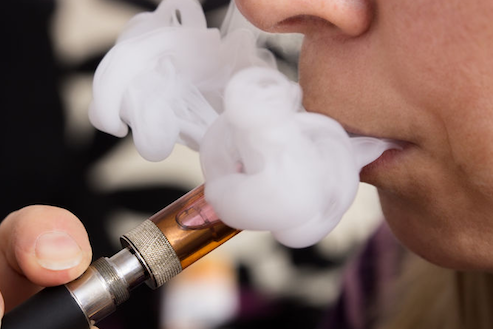Crescent City Vape Blog
Your source for breaking news, innovations, research, and clarity on electronic cigarettes and vaping.

This study, called Effect of Smoking Abstinence and Reduction in Asthmatic Smokers Switching to Electronic Cigarettes: Evidence for Harm Reversal, was conducted by Riccardo Polosa, Jaymin Morjaria, Pasquale Caponnetto, Massimo Caruso, Simona Strano, Eliana Battaglia, and Cristina Russo, and published on May 8, 2014 in the International Journal of Environmental Research and Public Health.
You can see the full study here. Below is our review of the study and its findings.
Summary & Review
 This study compared the effects that e-cigarettes have on asthmatic smokers to the effects that traditional cigarettes have on asthmatic smokers. E-cigarettes have been marketed as safer alternatives to traditional cigarettes and have been shown to reduce consumption of cigarettes in regular smokers.
This study compared the effects that e-cigarettes have on asthmatic smokers to the effects that traditional cigarettes have on asthmatic smokers. E-cigarettes have been marketed as safer alternatives to traditional cigarettes and have been shown to reduce consumption of cigarettes in regular smokers.
In the study, multiple asthmatic parameters were measured, including spirometry data and subjective asthma control in 18 asthma patients who were smokers and switched to e-cigarettes.
At the end of the study, there were significant improvements in spirometry, and asthma control (how the patient felt); these significant improvements were found in both dual (e-cigarette and reduced cigarette) and single users (just e-cigarettes). Decrease in exacerbations was reported as well, but was not significant.
The study indicates both subjective and objective improvements in asthma-related symptoms in users who have substituted e-cigarette use for cigarette smoking. Because e-cigarettes are reportedly less harmful than traditional cigarettes and can curb cravings for traditional cigarettes in addition to improving certain asthma-related symptoms, this study shows that e-cigarettes are a viable option for asthma patients who have not been able to quit smoking traditional cigarettes by any other means.
The percentage of asthma patients who smoke is comparable to the percentage of all smokers in the general (non-asthmatic) population. Asthma patients who smoke seem to have a lower response to inhaled corticosteroids (ICS) and other oral corticosteroids (inhalers) compared to asthma patients who do not smoke. It has been found that smoking cessation can reverse worsening asthma symptoms and lung function changes. However, reported levels of smoking cessation in asthma patients are low due to the lack of awareness of the direct correlation between smoking and their poor respiratory symptoms.
Materials & Methods
An electronic cigarette is a battery-operated device designed to deliver nicotine without burning tobacco. Instead, it heats e-juice, a mixture of propylene glycol and/or vegetable glycerine, flavorings, and nicotine. These devices can be attractive to smokers who see their smoking as a recreational habit and want to continue it in a less harmful manner, and also attractive to smokers who have had trouble quitting using available medications.
Data was collected during four visits, using multiple data points. The four visits included a pre-baseline visit (the subjects of the study were existing patients at a clinic), a baseline visit just before switching to e-cigs, and two follow-up visits, one at about 6 months and the next at about 12 months from the baseline visit.
At each visit, spirometry data, exacerbation values, and a Juniper’s Asthma Control Questionnaire (ACQ) score (subjective test of how the patient feels) were collected.
- Spirometry measures how much air you can inhale and exhale, and how fast you can exhale. Data was collected using a spirometer, a tube through which a subject inhales and exhales for an allotted amount of time. The data produced may be fed into a computer that converts the readings into numerical data values to allow for easy analysis. Spirometry data is used to evaluate the severity of asthma in a patient and sometimes to diagnose Chronic Obstructive Pulmonary Disease (COPD).
- An asthma exacerbation is an episode of progressive worsening of asthma symptoms, including shortness of breath, wheezing, coughing, and chest tightness.
- Juniper’s Asthma Control Questionnaire (ACQ) is a simple questionnaire completed by asthma patients to determine the effectiveness of treatment or medication. The patient simply answers questions about the way he or she feels and these answers are compared with the patient’s earlier ACQs.
Study Results
As to be expected, there was no significant difference in data collected at the pre-baseline and baseline visits. At the six-month, or first follow-up visit, there were significant improvements in both ACQ scores and some spirometry data points. At the 12-month, or second follow-up visit, there were significant improvements in ACQ scores, as well as several spirometry data points.
During the observation period (time during which the e-cig was used), there were no reported severe adverse effects or acute exacerbations of asthma symptoms (coughing, wheezing).
This study shows, for the first time, improvements in asthma control, airway hyperresponsiveness, and pulmonary function in asthmatic smokers as a result of lowering or ceasing cigarette consumption by switching to e-cigs.
The high success rate of quitting or reducing smoking may be because of how easily the e-cig can replace the physical and behavioral habits that are formed through cigarette smoking (such as the hand-to-mouth action). The results of this experiment suggest that the harmful effects of smoking on asthmatic airways may be reversed.
The improvement in lung function could be due to the lack of pro-inflammatory effects in the airways caused by cigarettes. This improvement in lung function could also be associated with the asthmatics’ increase in beneficial effects from inhaled corticosteroids (inhaled acetylcholine or inhaler), which are diminished by cigarette smoking (most smoking asthmatics experience little to no relief from corticosteroids).
Although it is impossible to know if the patients’ use of e-cigs caused the positive improvements seen in these mild-to-moderate asthmatic smokers in this study or not, evidence clearly suggested that e-cig use was not harmful to asthmatic smokers.
Conclusion
This study shows that e-cigarettes help reduce or cease cigarette consumption in asthmatic smokers and therefore reduce the affliction of smoking-related asthma symptoms.
Due to the positive findings of this experiment, we can confidently support the idea that smoking cessation or tobacco harm reversal using e-cigs is a valuable alternative to smoking not only in habit replacement but in improved pulmonary function as well.

 The following is a summary of a public lecture given by Dr. Lynne Dawkins at the University of East London on July 3, 2013, called “Electronic Cigarettes: What We Know So Far.”
The following is a summary of a public lecture given by Dr. Lynne Dawkins at the University of East London on July 3, 2013, called “Electronic Cigarettes: What We Know So Far.” Characterization of chemicals released to the environment by electronic cigarette use (ClearStream-AIR project): Is passive vaping a reality?
Characterization of chemicals released to the environment by electronic cigarette use (ClearStream-AIR project): Is passive vaping a reality? 
